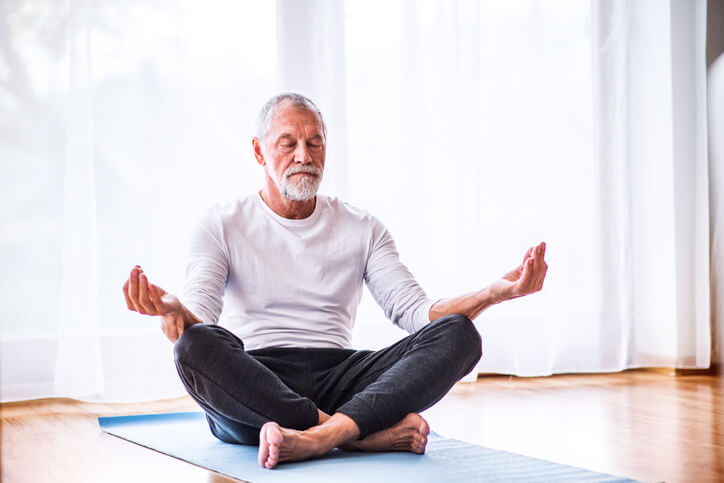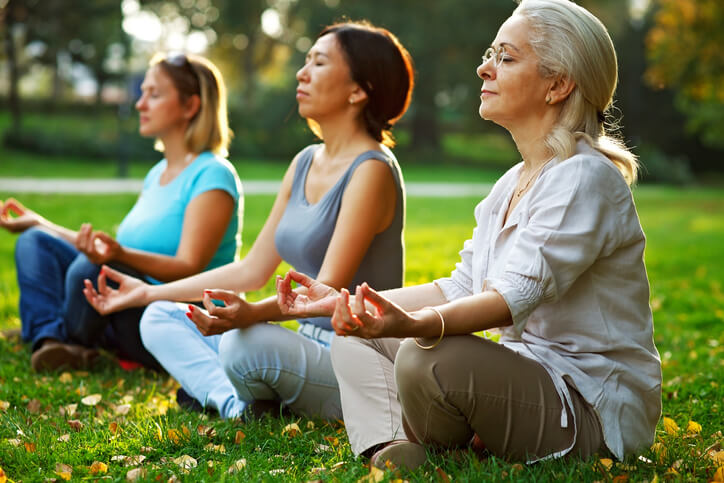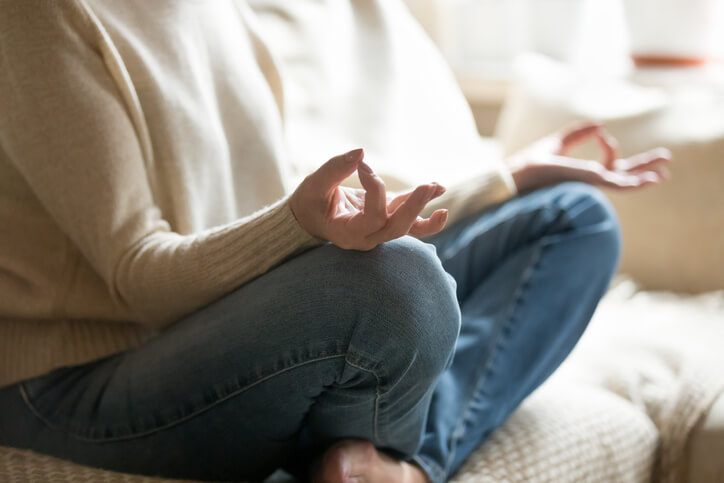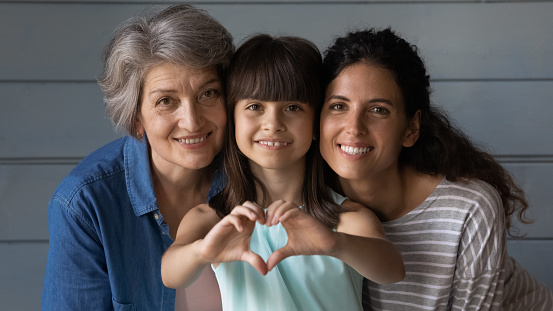Meditation may bring to mind images of spirituality and solitude—of quiet, candlelit rooms in sacred spaces with music playing softly in the background. But the beauty of meditation is in its simplicity and accessibility. The benefits touch people of all ages, wherever they are able to find time and space to practice it.
The increasing popularity of this ancient mind-body practice likely correlates to the real-life stresses of the modern older adult. Empty nest, retirement, caring for aging parents, chronic pain, losing friends and family to illness or disease: The difficult life transitions in which many older adults find themselves tend to spark an inner conflict and unrest that’s hard to silence.
And, if you once threw yourself into work but are now retired—or used to busy yourself with the kids’ schedules but are now an empty nester—the old methods of distraction are no longer a viable option. Without the pressing needs of children or a career in the forefront, your mind may quickly drift to the past—Did I do a good job as a parent? Should I have worked longer? Why didn’t I travel more?—or to future fretting: What if I get Alzheimer’s? What if my money doesn’t last? What if my grandkids never visit?
Instead of these counterproductive wanderings, learn how to focus on the present in this new chapter of your life. And, be fully aware of—and mindful in—the present moment.
Benefits of Meditation
Given the intimate personal nature of meditation—and, as experts suggest, it is best practiced in isolation—the benefits may vary among individuals. However, if you commit to an intentional, regular practice of meditation (you don’t have to be an expert!), the following benefits of meditation are universal and based in scientific fact:

- Reduces anxiety
- Prevents and treats depression
- Minimizes the effects of race and age bias
- Improves cognition
- Increases body satisfaction
- Reduces mental distractions
Dementia
As many older adults watch loved ones lose cognitive and physical function to dementia and Alzheimer’s, research around the alleviation of its signs and symptoms via meditation and mindfulness is encouraging and empowering. According to Medical News Today, for participants who committed to just 12 weeks of 12 minutes a day of listening to music or doing simple yoga meditation, the results were overwhelmingly positive—showing improvements in mood, sleep, stress levels, and quality of life.
Menopause
Menopause is another later life transition whose symptoms may be mitigated by the practice of meditation. Nina Anders, blogger at Sharing a Journey, started meditating in her late forties when she entered perimenopause and says it’s been an integral part of her life ever since. And it did more than alleviate menopausal symptoms.
“My meditation practice has aided in healing, connecting me more deeply to the depths of my soul, has helped guide my business, and has enhanced my intuition,” says Anders. “Most of the people in my yoga classes have been women 45 and over; all of us feel deeply that it enhances our lives and the lives of those around us.”
Other Health Challenges
Maybe you struggle with achieving restful sleep, or staying positive during tense situations or difficult life changes. Perhaps you’ve noticed that you have a harder time focusing on daily tasks. Or maybe you have digestive problems that are a daily source of pain or stress. As reported by the nonprofit Mindworks, research shows a significantly positive impact on all of these areas among older adults practicing mindfulness and meditation.
Mental and Emotional Health
As the kids move on to starting their own families, as more friends and parents pass away, or as you may struggle with transitioning from full-time work into retirement, the cumbersome burdens of grief, loss, and loneliness may sometimes feel too great to bear.

Meditation allows for quiet reflection, a place to process these influential changes and move into a new stage of life with resiliency and grace, rather than defeat and stagnation. As you become more self-aware through the practice of meditation, you may find you’re better able to control your emotions and reactions—not that you won’t feel the pain or sting of loss, rejection, or disappointment, but that you’ll know better how to move forward once you’ve allowed yourself to freely experience the feelings around them.
AARP suggests that the practice of mindfulness and meditation leads to making better choices. And, as decision-making around caring for your aging parents or moving to be closer to grandchildren is particularly vital in this stage of life, this additional benefit is a powerful one.
“After seeing the benefits for myself, I routinely advocate and teach meditation to my clients,” says Cincinnati-based Mark Levine, LICDC-CS, MAC, of Minds at Peace. “I recently worked with a teacher in her fifties who retired. Suddenly her mind, previously occupied with lesson plans, drifted continuously to negative thoughts and self-doubt,” Levine explains. “By teaching her to meditate—learning to see thoughts as just thoughts, approaching her mind with self-compassion and curiosity—she went from crying in my office to a month later laughing and joking about her mistakes.”
How to Begin a Meditation Practice
Ready to begin but not sure where or how to start? Go online: A number of free resources are available. Start by researching beginner guided meditation videos or podcasts, or checking out available smartphone apps. Consider the following videos, podcasts, and apps as you explore meditation for the first time:

Meditation Apps, Podcasts, and Websites to Get You Started
Headspace
The Headspace app is available for iPhone and Android users. When you sign up, you get your first 10 sessions free. After that, unlimited meditation sessions are available for a monthly fee. The app also allows you to track your progress and view your accomplishments.
Soundrown
Ambient noise helps filter out the auditory distractions that often lead to wandering (or negatively spiraling) thoughts. The free tracks for instant listening available through the Soundrown website—which also can be found on the SoundCloud platform—offers focus-friendly sounds on-demand.
Calm
The popular Calm app providers a strong foundation for mindfulness beginners. It is focused on getting better sleep and having less stress. There are over 100 guided meditations plus their unique “sleep stories” feature, in which “soothing tales [are] read by well-known voices” help you unwind and fall into a deep sleep.
Guided Meditations by Tara Brach
If you’re interested in the ancient spiritual influences on meditation, Tara Brach’s website and its accompanying podcast may intrigue you. Brach is the founder of a Washington, D.C.-based meditation center—one of the largest in the nation—and thoughtfully combines her background in psychotherapy with trainings in Buddhist teachings.
The Meditation Podcast
Narrated by Jesse and Jeane Stern, The Meditation Podcast offers “simple, straightforward meditations” for those “dealing with a health or emotional challenge.” Using audio tones that modulate brain waves and help bring about relaxation, some listeners have “given profound testimonies about how this podcast has helped them deal with strokes, anxiety and emotional loss.”
Guided Meditation for Beginners on YouTube
Entering this as a search term will return hundreds of options. Find the one that piques your interest in terms of visuals, approach, music, and, of course, the guide. The more invested you are, the better your results will likely be.
The Muse Headband
Mark Levine recommends using a tech tool, the Muse headband, in conjunction with the Ten Percent Happier app for real-time neurofeedback. The book Meditation for Fidgety Skeptics by Dan Harris—co-founder of the Ten Percent Happier app—is also a resource Levine recommends to many of his coaching clients who are just dipping their toes into the meditation waters.
Meditation for Beginners
The National Center for Complementary and Integrative Health (NCCIH), part of the National Institutes of Health, describes meditation practice as a “focus on the interactions among the brain, mind, body, and behavior.”

While there are many types of meditation, most share these four common elements, per the NCCIH: a quiet and distraction-free location, a comfortable position (be it sitting, walking, or lying down), focused attention (using intentional breathing, a cherished object, or by repeating words), and an open mind.
How Do You Meditate?
With the basic principles in mind, here’s how to start where you are with what you have:
- Find a comfortable, quiet place around the house, in your backyard, or even at a favorite nearby park.
- Sit in a chair, put your feet up, or prop yourself up with pillows in bed. Do whatever is the most comfortable position for you. Experiment a little at first to find what produces the least amount of discomfort, as you’ll stay in this position for an extended period of time. As stated at Synchronicity.org, find the position that “produces the least amount of body noise.”
- Can’t sit still? Walking meditation or “mindful walking” is great for the body and the mind. Thich Nhat Hanh, renowned Zen Master and poet, and founder of the Engaged Buddhist movement, says this: “Walking meditation unites our body and our mind. We combine our breathing with our steps. When we breathe in, we may take two or three steps. When we breathe out, we may take three, four, or five steps. We pay attention to what is comfortable for our body.”
- While 15 minutes is recommended by the experts for optimal outcomes, it’s okay to start small, with even just 5- or 10-minute meditation sessions. Recall the positive effects of mindful practices for those living with dementia who did just 12-minute sessions for 12 short weeks, and you’ll see: Meditation doesn’t have to be hard to be helpful.
- Don’t worry if your mind wanders or if you lose focus while trying to meditate. Experts say it’s best to observe your thoughts as they arise and then return to the breath.
Meditation Techniques
The goal of meditation is a calm mind and body; however, any challenges you may have with being able to focus can produce the opposite effect. For those struggling to quiet the body and mind, following a specific script or model may be helpful. This one is adapted from Psychology Today:
- Think of a word that stirs a positive emotion for you—an emotion perhaps you’d like to feel during and after meditation—such as joy or peace.
- Picture that word in your mind. Spell it out on your arm with your fingertips. Tap out its syllables on the palm of your hand. Whatever helps you keep that word front and center, go with it.
- Think of that emotive word as a color, and picture it in that color. Then picture the backdrop to the word in another color.
- Keep writing the word in your head, one letter at a time, perhaps even saying the letters out loud in a soft voice.
- Repeat these steps for 10 minutes (setting a timer will help you stay on track).
As with anything new, your comfort and ease with meditation will grow with time and practice. Don’t get discouraged if you find that your mind and/or your body is distracted the first few times you meditate. Keep moving forward, even if you don’t feel any noticeable difference. As time goes on, these mindful moments will add up and eventually transform your restless mind and body into one at peace.
Have you seen improvements in your life since beginning a meditation practice? Leave a comment and tell us about your experience!







Very helpful article with many resources. Has great suggestions for beginners like me
I tried my best to find podcasts that would get me into a good mood, in times when I need to escape from the news cycle. There’s probably a huge number of pop culture podcastson in this area. What do you think? I love watching old movies and listening to the discussion of the films for hours. It gives me joy. I hope that you will find something here that brings joy.
Thanks for the great tips about how to start meditation. I’ll certainly give it a go as I’ve been meaning to try this out for ages. My only experience in the field of alternative nature health was when I lost my voice and got help from a homeopathy site.
Thank you for this very important and useful post, which I will share. 🙏
I am so ready for this, I’ve been seeking for a long time for something that will work for me and I’m feeling confident already. Thank you so much can’t wait to begin. Patience is virtue
Very nice article. I have not started meditation practice. But from this article it seems it is wonderful. Worth practising
An interesting discussion is price comment. I think that you should write extra on this matter, it may not be a taboo topic but typically individuals are not sufficient to speak on such topics. To the next. Cheers
I recently acquired Tinnitus in my right ear. It is loud and goes 7/24. I was near my wits end then I found mindfulness through Dr. Jennifer Grants. She uses a program similar to what JOhn Cabit Zen developed. I have been practicing for about 8 months now. My tinnitus is still there but it is not longer bothersome and everything else in my life has become more balanced. I am actually grateful for my tinnitus now due to the enlightenment that is coming my way.
Very well written & informative article!!
I am suffering from horrible anxiety etc due to having to move from my home, anyone have a Facebook or other online meditation you recommend?
I have been meditating off and on for many years. I have been more focused in the last few years since retiring, loss of a loved one, and other changes in my life. It has really changed my way of looking at my life. Rather than focusing on the negative, I focus more on the positive. Furthermore, and perhaps a more amazing part of meditation evolved last year when I broke my leg. I was in tremendous pain and my MD prescribed OxyContin. I didn’t want to take it. I started meditating for “Pain Management”. (Found online). It worked. Never took Oxy.
I have been meditating for 10 years. It has been very helpful in all areas of my life.
I use guided meditations. The two best free apps are: insight timer,. And UCLA mindful.
Please check them out.
Thank you for the comment!
excellent post, very informative. I wonder why the other experts of this sector don’t notice this. You must continue your writing. I’m sure, you’ve a great readers’ base already!
Great article. Thanks. C Wilson Meloncelli(https://www.cwilsonmeloncelli.com/) website also tackles about meditation and how mindset can greatly trigger the flow state. Check it out.
Meditation is the boon for everyone. Thanks for amazing contents!!!
I was suffering from anxiety and depression in the year 2012, then I learnt meditations and my body started healing.
Meditation has helped me calm my nerves dealing with this stock market and has increased my cognitive ability as well as my sleeping
That’s wonderful! Thank you for sharing your experience with meditation with us, John!
I caught the meditation bug over 25 years ago. It helps me with regulating my emotions and anxiety.
I enjoyed it so much I started hosting a free online daily meditation practice on Facebook.
Breathing is free and can be helpful at any time.
Thank you for a great article! 🙌🏾🧘🏾♂️🙌🏾
Hi Barbara – That’s amazing! Thank you for sharing your experience with us.
Amazing !,
im trying to focus on meditation and i found below recently meditation music that can help me
https://youtu.be/PthKsnO6ikA
Check it out
I’ve been meaning to do this as a ritual for years. After reading this, NOW is the time to start!
Meditation has changed my life for the better. I am calmer, slow to speak, more emotionally balanced. I recommend it. It will improve your life.
I haven’t started yet but I plan too